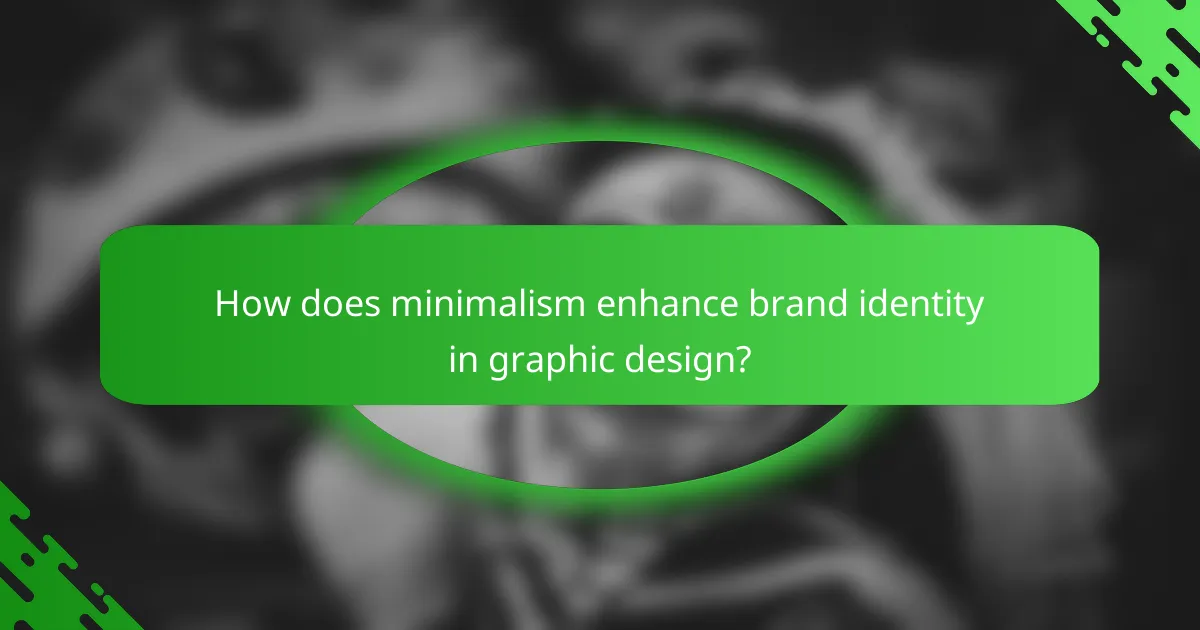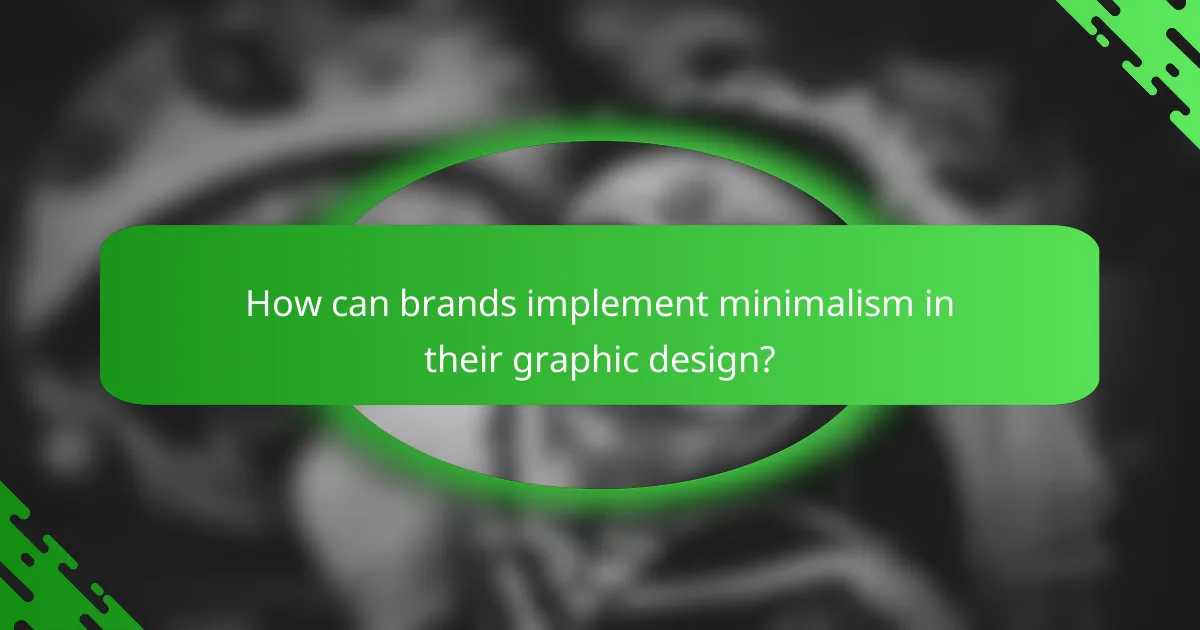Minimalism in graphic design is a powerful strategy for modern brands, emphasizing simplicity and clarity to effectively convey core values. By eliminating distractions, brands can create memorable identities that resonate with their audience, enhancing both recognition and user experience.

How does minimalism enhance brand identity in graphic design?
Minimalism enhances brand identity by focusing on simplicity and clarity, allowing brands to communicate their core values effectively. This approach eliminates distractions, ensuring that the brand message is both memorable and impactful.
Clear visual messaging
Minimalist design prioritizes essential elements, making visual messaging straightforward and easy to understand. By using fewer colors, shapes, and text, brands can convey their message quickly, which is crucial in today’s fast-paced digital environment.
For example, a logo with a simple icon and clean typography can communicate a brand’s essence without overwhelming the viewer. This clarity helps consumers grasp the brand’s purpose at a glance, fostering immediate recognition.
Stronger brand recognition
Minimalism contributes to stronger brand recognition by creating distinctive and uncomplicated visuals that stand out. A well-designed minimalist logo or graphic can become iconic, as seen with brands like Apple and Nike, whose simple designs are instantly recognizable worldwide.
To achieve this, brands should focus on creating unique, memorable elements that can be easily associated with their identity. Consistency in minimalist design across all platforms reinforces recognition and builds trust with consumers.
Increased emotional connection
Minimalist design can foster a deeper emotional connection with consumers by evoking feelings of calm and clarity. A clean aesthetic often resonates with audiences seeking simplicity in a cluttered world, making them more likely to engage with the brand.
Brands can enhance this emotional connection by using minimalist visuals that reflect their values and mission. For instance, eco-friendly brands might use earthy tones and simple designs to communicate sustainability, appealing to environmentally conscious consumers.

What are the key benefits of minimalism for modern brands?
Minimalism in graphic design offers several advantages for modern brands, including enhanced clarity, cost efficiency, and lasting visual appeal. By stripping away unnecessary elements, brands can communicate their messages more effectively and create a memorable identity.
Improved user experience
Minimalist design prioritizes simplicity, making it easier for users to navigate and interact with a brand’s digital platforms. Clear layouts and focused content reduce cognitive load, allowing users to find information quickly and efficiently.
For example, websites with minimal distractions often see lower bounce rates and higher engagement. Brands should consider using ample white space, straightforward navigation, and concise messaging to enhance user experience.
Cost-effective design solutions
Adopting a minimalist approach can lead to significant cost savings in both design and production. Fewer elements mean less complexity, which can reduce the time and resources needed for development and revisions.
Brands can leverage simple design tools and templates that require less customization, allowing for quicker turnaround times. This approach is particularly beneficial for startups and small businesses with limited budgets.
Timeless appeal
Minimalism tends to have a timeless quality, as it focuses on essential elements rather than fleeting trends. This can help brands maintain a consistent image over time, reducing the need for frequent redesigns.
Brands that embrace minimalism often find their designs remain relevant and appealing, even as styles evolve. By investing in a minimalist aesthetic, companies can create a lasting impression that resonates with audiences across generations.

How can brands implement minimalism in their graphic design?
Brands can implement minimalism in graphic design by prioritizing simplicity and clarity in their visual communication. This approach involves stripping away unnecessary elements to focus on what truly matters, enhancing brand recognition and user experience.
Focus on essential elements
To embrace minimalism, brands should identify and highlight only the most crucial elements of their design. This might include a single logo, a key message, or a primary image that conveys the brand’s identity effectively. Avoid clutter by eliminating distractions that do not contribute to the core message.
For example, a tech company might choose to showcase its latest product with a clean, high-quality image and a succinct tagline, allowing potential customers to grasp the offering quickly. Regularly review designs to ensure that every element serves a purpose.
Utilize negative space
Negative space, or the empty areas around design elements, plays a vital role in minimalism. By effectively using negative space, brands can create a sense of balance and clarity, allowing the viewer to focus on the essential components without feeling overwhelmed.
For instance, a fashion brand might use ample white space around product images to draw attention to the items themselves. When designing, consider how much negative space is present and adjust accordingly to enhance visual appeal.
Choose a limited color palette
A limited color palette is a hallmark of minimalist design, helping to create a cohesive and recognizable brand identity. Brands should select a few primary colors that reflect their personality and values, avoiding excessive hues that can confuse or distract the audience.
For example, a wellness brand might opt for soft greens and whites to evoke feelings of calm and health. Stick to two to four colors for consistency across all branding materials, ensuring that the design remains clean and focused.

What are the best tools for minimalist graphic design?
Some of the best tools for minimalist graphic design include Adobe Illustrator, Canva, and Figma. Each of these platforms offers unique features that cater to different design needs while promoting simplicity and clarity in visual communication.
Adobe Illustrator
Adobe Illustrator is a powerful vector graphic design tool widely used for creating minimalist designs. Its precision allows designers to create clean lines and shapes, essential for minimalist aesthetics. The software supports various file formats, making it versatile for different projects.
When using Illustrator, focus on utilizing the pen tool for creating custom shapes and the artboard feature to manage multiple designs efficiently. Consider exploring the use of grids and guides to maintain alignment and balance in your minimalist layouts.
Canva
Canva is an accessible online design tool that simplifies the graphic design process, making it ideal for those new to minimalist design. With a user-friendly interface, it offers a variety of templates and elements that can be easily customized to fit a minimalist style.
To effectively use Canva for minimalist designs, start by selecting a simple template and remove any unnecessary elements. Utilize the color palette feature to maintain a cohesive look, and leverage the drag-and-drop functionality to arrange components intuitively.
Figma
Figma is a collaborative design tool that excels in creating minimalist user interfaces and web designs. Its real-time collaboration feature allows multiple users to work on a project simultaneously, making it ideal for teams focused on streamlined design processes.
When working in Figma, take advantage of components and styles to ensure consistency across your designs. Use the layout grid feature to create balanced compositions, and remember to keep typography simple and legible to enhance the minimalist approach.

How does minimalism impact consumer behavior?
Minimalism significantly influences consumer behavior by simplifying choices and enhancing visual appeal. This design approach helps brands communicate their message more effectively, leading to increased engagement and purchasing decisions.
Increases purchase intent
Minimalist design reduces clutter, allowing consumers to focus on essential elements like product features and pricing. When brands present information clearly and concisely, it can lead to a higher likelihood of purchase, as customers feel less overwhelmed by options.
For instance, a clean website layout with straightforward navigation can improve user experience, resulting in increased conversion rates. Brands that adopt minimalism often see a boost in sales, particularly in competitive markets where clarity can differentiate them from others.
Enhances brand loyalty
Minimalism fosters a strong emotional connection between consumers and brands by creating a consistent and recognizable identity. When a brand maintains a simple yet effective design across all platforms, it builds trust and familiarity, which are crucial for loyalty.
Brands like Apple exemplify this, as their minimalist aesthetic resonates with consumers, encouraging repeat purchases. Additionally, a streamlined experience can lead to positive associations, making customers more likely to recommend the brand to others.



